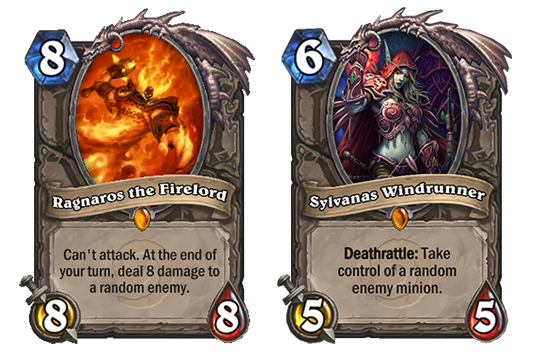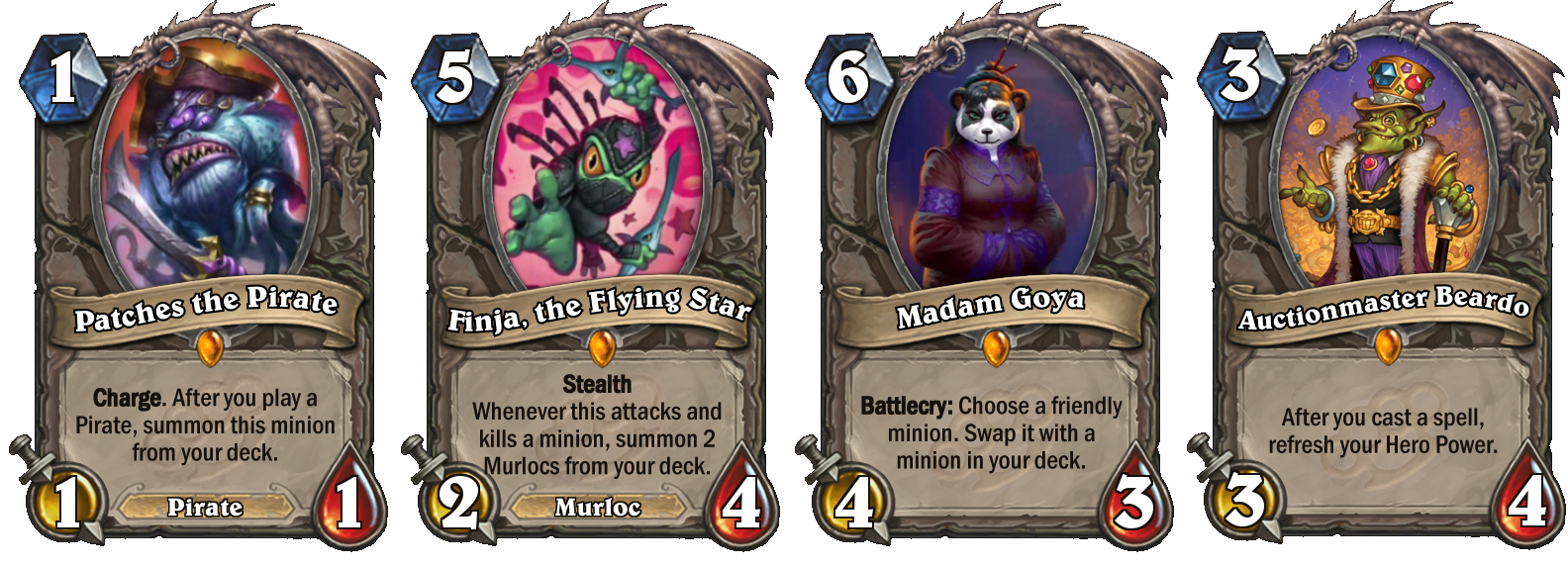Having passed its three-year anniversary since the start of its open beta period, the game Hearthstone is far from the new kid on the block. Newer games such as Overwatch have become the new hotness in esports and Hearthstone's challenges reflect those of a mature game rather than a juvenile one. Last year's key challenge with Hearthstone, in terms of the (overlapping) competitive and day-to-day scenes, was how to deal with the inevitable consequences of an ever-increasing card pool. This issue was addressed to a degree with the introduction of the Standard and Wild format split.
While the issue of how to refine the concept of a core set in Hearthstone is not fully resolved, other, larger issues with the game are popping up in 2017. These are things that need to be addressed in order to keep competitive Hearthstone a viable enterprise. With respect to actual execution, Blizzard's events for Hearthstone on the esports front have become more professional, with more clearly defined rules and better company support for these types of events. Hearthstone's biggest problems these days involve the central design of the game -- questions that require more compelling answers than they have so far received.
What is Hearthstone?
I'm not talking literally, but more in the philosophical sense. Whereas a game like Overwatch was envisioned long before release as a game with a serious competitive aspect, Hearthstone's popularity on this front was a bit of a surprise. The game was simply not designed from the ground up with the intention of it becoming an esport. The needs of a light, casual card game and a competitive game have conflicted on multiple occasions.
As balance issues go, the biggest challenge has been the design team's expressed desire to keep cards with as few changes as possible. One argument given by Ben Brode, Hearthstone's Game Director, is that they have concerns about cards being consistent. They don't want someone who hasn't played the game for a while to come back and see that all their cards are different from when they left. This may or may not be good for the casual player -- which we'll get into here -- but this creates problems for the game from a competitive standpoint.
Change comes slowly
One of the benefits of a digital card game, compared to a physical one, is the relative ease in changing card text. It's also an ability that Blizzard's Team 5, the group behind Hearthstone, has used quite sparingly in its history. Even when Team 5 was being more aggressive than usual in 2016 with major card changes in April and October, that was still a six-month period in which nothing was changed, outside of the extremely minor edit of making the rarely played Silithid Swarmer into a Beast card.
It would be one thing if there were no changes made because of a vibrant, balanced meta, but that was not the case during the months in question. During that time, the game developed into what the community called "Shamanstone," with Aggro and Midrange Shaman decks dominating the ladder -- a state that still exists today -- and Paladin and Priests dying out of competitive play. Blizzard just announced balance changes for Small-Time Buccaneer and Spirit Claws, and while these are helpful changes, these types of modifications typically happen when something has already been problematic for far too long.
Fixing stale metas with a sledgehammer
While Paladin remains dead, Priest is now more viable in competitive play, but to make this happen, Blizzard had to implement changes in the bluntest, most inelegant way possible: by printing extremely overpowered cards for Priest that were designed for very specific archetypes.
While this did have an overall positive effect on the Priest class in tournaments, it's also a brute force solution to a fundamental problem. Under the Standard format, classes with weak core sets need a constant influx of overpowered cards just to get the classes to the level of being balanced. New content needed only for plugging holes in the old design is content that can't be used as effectively to advance interesting game space. And when a class with a weak core set doesn't see that flow of crazy-good cards, like Paladin, it becomes an irrelevant class.

Blizzard is taking a new approach here by announcing, along with the Year of the Mammoth announcement, that a number of classic, iconic cards -- including Sylvanas Windrunner and Ragnaros the Firelord -- would be removed from the Standard set. It is labeling these removed cards as the initial entrants in the "Hall of Fame" set. But if these cards are problematic for a Standard meta, then isn't exiling them rather than simply toning down their effects still an inelegant solution?
Predetermined design space
While in itself, Mean Streets of Gadgetzan was an expansion with all sorts of interesting cards, it also continued a trend of Blizzard printing cards for particular archetypes, rather than more versatile cards. "You will make a handbuff deck!" "You will make a Jade deck!" "You will make a Reno deck!" The majority of the Mean Streets of Gadgetzan cards fill these commands. And when you essentially predetermine all the decks that will be created, the meta stops moving very quickly. MSG gave powerful tools to specifically push Aggro Pirate decks, Jade decks, Dragon Priest decks and Reno Kazakus decks. And that's exactly what happened. Team 5's design philosophy is for players to discover deck archetypes, but if the strongest tools given in the form of new cards are extremely specialized, those are the decks you're going to get.
The short content lifespan
By making specific decks overpowered, Blizzard has essentially made the Standard format even smaller than the two-year window that the format change ostensibly brings. The new decks are so powerful that previously seen decks such as N'Zoth/C'Thun, Secret Hunter and Beast Druid have become irrelevant long before that content rotates out. Blizzard talks about the casual player experience, but if a player isn't happy to see their cards change while they don't play, how would that same player who had a N'Zoth Paladin deck last summer feel when they come back to the game only to find it has been deck power-creeped out of competition? Three full expansions a year improve the card pool considerably, but Blizzard still has to demonstrate that it can make all the expansions within a Standard rotation remain somewhat relevant; simply increasing the velocity in which deck archetypes change isn't enough.
The Aggro menace
One of Blizzard's long-standing problems remains the lack of balance on aggressive, low-mana decks that focus on getting a lot of minions/weapons out early and going right to the face. One-mana cards such as Small Town Buccaneer/Patches the Pirate, Spirit Claws and Tunnel Trogg have wildly disproportional upside for the mana cost, something that could have been seen a couple years ago with the dreadful Undertaker Hunter meta. Slower decks simply have limited catch-up options to tech in to survive this early onslaught, leaving the game simply over on turn five way too often. Changes in individually strong cards that push this are helpful, but you're still left with the same basic problem that catch-up mechanisms for Midrange and Control decks are late enough that you too frequently only delay the loss by a few rounds rather than turning the tide.

Aggro decks are necessary as a check on especially greedy decks, but there has to be a limit. Getting three health from an Earthen Ring Farseer or four from a Refreshment Vendor just isn't enough for most decks, which is why you see Reno played as a necessary survival mechanism. As a result of the Pirate and aggressive Jade package, Midrange decks are essentially dead in competitive Hearthstone, both in tournaments and on ladder. In Vicious Syndicate's Data Reaper analysis, Shaman and Warrior decks made up more than half of the decks played by the end of January. Hunter and Paladin combined made up less than 5 percent.
Diversifying the competition
While there's a lot to be said for having the marquee event based on Standard format, it would also be nice to have a little more variety. With Standard metas getting stale so quickly, it would be nice to see more of a competitive focus on the other game modes. Pushing competitive Wild format adds some diversity that's sorely missing. Arena games have a much wider card pool and create a lot of interesting card interactions that you never get to see in Standard. And Tavern Brawl challenges bend and break the rules, exploring the whole Hearthstone space more widely than in a billion Aggro Shaman mirror matches.
The World Series of Poker is known for its main event, but it includes a number of other events beyond the straight no-limit Texas Hold'em. Omaha, Stud, Limit and Lowball are all games that increase the exploration of the poker space. There's no reason why Blizzard couldn't hold an Arena championship at BlizzCon or push Challengestone-type events.
Blizzard has talked a lot about and continues to discuss possibly making Wild events more prominent, but until these plans come to fruition, Wild format simply exists as a niche format serving as a graveyard for old favorites. If Azure Drake and Power Overwhelming were moved from Standard to Wild because the cards were too problematic, then shouldn't they have been toned down before throwing them into the Wild pool?
Fixing the balance issue
By addressing the balance issues more aggressively, the esports product becomes more compelling to the viewers. There can only be so many tournaments of near-identical Aggro Shaman/Aggro Pirate/Reno decks with the occasional Dragon Priest or Miracle Rogue thrown in before it becomes repetitive. If Blizzard wants Hearthstone to remain a significant esport over the long haul -- and more than a game people play on their phones while going to the bathroom -- a more proactive approach is needed. Don't let issues fester for months and then fix them: Fix these things before they become serious problems, with regular balance patches.
And please, never print an overpowered one-drop again.
